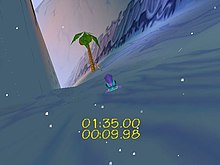Tonic Trouble
Assuming the role of Ed, the player is tasked with solving puzzles and defeating enemies to acquire the tools to conquer Grögh and repossess the container to create an antidote.
[2][3] The playable character, Ed, navigates three-dimensional environments through platforming and entering portals, while wielding a peashooter (used in a first-person perspective); new gadgets are rewarded as more levels are completed.
[2][3][4][5] Gadgets are created by a mad doctor character,[6] who builds the peashooter, a bow tie that enables Ed to fly, a diving helmet for underwater exploration, a belt that functions as a cloaking device by letting him take the appearance of enemies, and a pogo stick that allows him to traverse lava and stomp open trap doors.
Exhausted from the hunt, Ed proceeds to drink an unidentified liquid from a container, but as he spits it out onto the floor, screws come alive and open a trapdoor.
Ed takes a small spaceship to Earth to meet the inventor Doc and his daughter Suzy, who Xyz said would give aid in his mission.
[15] The game engine, known as "Architecture Commune Programmation",[12] was built by fifty in-house staff over a course of eighteen months, with a total cost of US$4 million.
[16] Using the engine, the developers wanted to take full advantage of Intel's newest Pentium II generation of central processing units.
[30] Originally scheduled for November 1997,[21] Tonic Trouble saw multiple delays, with its release being pushed back to early 1998,[16] then to April 1998,[17] June 1998,[12] Q4 1998,[20] and 15 February 1999.
[31] According to an author at IGN, the version shown at E3 was in a rough state, lacking animation and suffering heavily from low framerates and stiff controls, though all of these issues had been resolved by the time they received a new preview copy in December 1998.
[40][41] Around February 1999, it was rumoured that Tonic Trouble and Rayman 2 would be releasing for PlayStation,[42] with that year's TGS line-up also shortlisting such versions for both games.
[43] In March 1999, Ubi Soft acquired a Dolby Pro Logic surround sound licence for usage within Tonic Trouble and Rayman 2.
[29][45] An eponymous Game Boy Color counterpart was developed by RFX Interactive and first shown at France's Milia expo in February 2000.
[47] It was released for Game Boy Color the same year, exclusively in Europe; Ubi Soft did not plan to bring it to the United States.
[8] Tonic Trouble was met with mixed reception; the review aggregator website GameRankings calculated a weighted average ratings of 53% for the Nintendo 64 version and 70% for the Windows release.
[54][55] Electronic Gaming Monthly thought that, in terms of level design, Tonic Trouble was "a tightly developed platformer"; the control scheme was similarly praised.
[3] Suzi Sez, reviewing the PC version for GameZone, enjoyed Tonic Trouble's "stunning" 3D graphics, "great" sound effects and music, "cute and fun" storyline, and unrelenting replay value.
[9] IGN's Game Boy Color review of Tonic Trouble, written by Tim Jones, described the controls as "tight and responsive" and the humour and visuals as "enjoyable".
Jones thought the graphics, seen as "clear" and colourful, complemented the level design, adding that the sprites boasted "excellent" and detailed animation.
Conversely, Electronic Gaming Monthly blamed the Nintendo 64 for the visual shortcomings, criticized boss battles for their lack of difficulty, and saw the music as insignificant, while also calling the main character "annoying" and camera system "confusing".
[5] Casamassina dubbed Tonic Trouble the S. S. Minnow to Rayman 2's Love Boat, observing the "generic feel" as its largest obstacle.
